The MGA Trans-Pyrenean Challenge
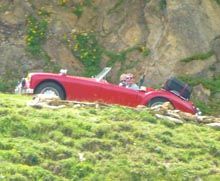
 Following our successful circumnavigation of Mont Blanc in the Alps in 2012 one of our crew members posed the question, “Where next?” To which another replied, “How about the Pyrenees?”
Following our successful circumnavigation of Mont Blanc in the Alps in 2012 one of our crew members posed the question, “Where next?” To which another replied, “How about the Pyrenees?”
And so it was that five of the six MGA Alpine crews plus another four intrepid MGA owners signed up for the challenge of driving the length of the Pyrenean mountain range from the Mediterranean Sea to the Atlantic Ocean in the summer of 2014. Were we to drive the adjacent main roads in France we would cover a distance of just 365 miles, but the route we adopted would be double that. It would cross the border between France and Spain nine times, visit Andorra and take in many of the highest mountain passes along the way. It would certainly be a challenge for our half-century old machinery.
Given that my MGA overheated on the steepest Alpine climbs, I followed the example of NAMGAR member, Colyn Firth, in the Alps and fitted a 10″ electric fan plus a 13-row oil-cooler only to find Colyn had moved on to twin 9″ fans. As the Pyrenees are noted for rain and even hailstorms, I also made good my 2013 Irish trip omissions and fitted the windshield header-rail seal and centre-clip. What could possibly go wrong?
My cooling provisions passed their first test before we had even left England, as we had an hour’s first gear crawl over the River Thames crossing on the London orbital motorway in c.80F summer heat. The car would have overheated for sure had I not been able to switch on the electric fan. Son Tom and I then enjoyed a mill-pond sailing from Portsmouth to the Atlantic coast of Spain, which saved us about 500 miles of driving through France.
After an overnight stop near Bilbao, we entered France and drove the c.400 miles to the Mediterranean coast. It was a long day’s drive, but torrential rain only forced a few drops over the windshield, so I judged the new seal and clip a success. A couple of days staying with friends gave time for our MGA to be checked, but the only attention required was the reattachment of the air-horn hose. I must have disturbed it when I fitted the oil-cooler. A few hours drive, albeit in 110F heat, took us to the rendezvous point where we met up with MGA friends old and new. Some had driven all through France, covering over 1000 miles before we even started our tour.
The sun was shining when the nine MGAs, all roadsters, met at Cap Cerbere, a point on the Mediterranean coast near the border of France and Spain; and after photos were taken, we embarked upon our challenge. As usual, we did not drive in convoy, but traveled singly or in twos and threes, following the route in organizer, Stuart Mumby’s, comprehensive route-book. After crossing the border into Spain, we briefly looped south-west of the Pyrenees, but then climbed the foothills and re-entered France.
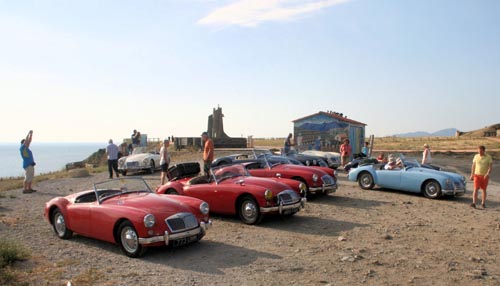
Most crews used restaurants for lunches, but Tom and I bought sandwiches for the first of a number of scenic picnics during the tour, often surrounded by lovely wild flowers.
This first day’s drive comprised a succession of progressively higher passes and after a brief diversion through the Spanish enclave of Llivia, we ascended the 6300 ft Col de Puymorens and then the 7900ft Port d’Envalira, the highest pass in the Pyrenees before descending to Andorra la Vella and our hotel. All the MGAs performed well, probably helped by the wide main roads having been engineered to avoid very steep gradients for commercial vehicles.
Andorra has a low tax regime, so most crews took advantage of the low fuel and alcohol prices before leaving the Principality for Spain and climbing the first pass of the day, the 6000 ft Coll del Canto. Here we found ourselves driving above cloud level, which at times rose up and enveloped us in mist. A welcome coffee was grabbed by some of us in Sort before cruising down the Val de la Noguera Pallaresa to La Pobla de Segur. Then, after another wildflower lunch on the Col de Creu de Perves, Tom and I headed back to the high Pyrenees, through the Tunel de Vielha, down the Val d’Aran then up over the 4200 ft Col du Portillon back into France. The real challenge of this second day was reaching our hotel in Bagneres de Luchon as the adjacent roads were closed due to a suspected gas leak. Happily, no explosion occurred.
On day three we began our use of the famous Tour de France cycle race routes. The upside was they had all been resurfaced for the 2014 event, held just a few days before us. The downsides were they were the steepest and narrowest climbs and were busy with amateur cyclists trying to emulate their heroes, so we needed to drive with care. Regular road signs displayed gradients and distances to summits, others warned drivers to not pass by cyclists too closely. As we prepared to tackle our first climb, the 5800 ft Port de Bales, a French SS Jaguar-like kit car came the other way, the driver curious about all the English MGAs.
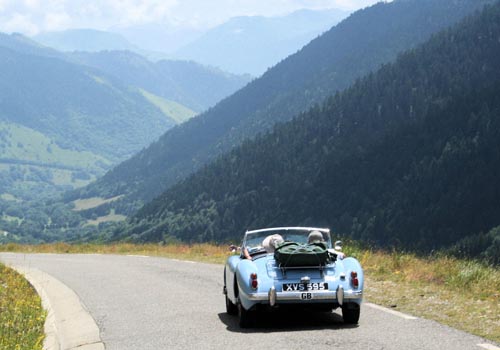
Some of the crews had fitted car-mounted video camcorders, but I relied on Tom using a hand-held one having been disappointed with fixed-mount camera results in the past. Examples of all our videos, together with still photos can be viewed on the event blog put together by Colyn Firth.
Following a spot of sightseeing in the pretty village of Cires we stopped to admire the extensive bunting strung across the river in Borderes Louron. Here we were approached by a resident who first admired our MGA and then told us that the English car she had really always wanted was a Morgan!
Stuart had timetabled day four as a rest day with possibly a visit to nearby Lourdes, but I think most of us took off in our cars to explore the notorious Tour de France cycle climb of the 6900 ft Col du Tourmalet. The road climbs c.4000 ft in just ten miles and was one I actually stopped half way up to give our engine a chance to cool down – the gauge was showing 220F even with the electric fan operating. I was glad that we were descending the other side which rises c.4500 ft in a similar distance, one of very few routes shown red and yellow on the road atlas due to trucks and buses being prohibited.
Day five started amusingly as we checked out of our hotel. A perplexed French lady approached us asking if we had seen her car. She said that she had parked it next to our red MGA the previous evening, but it had now seemed to have vanished! It turned out she had parked next to one of the other red MGAs that had been the only one parked at the time, but as it had already left by the time we checked out, she only had ours as an (incorrect) MGA reference point. She was soon safely reunited with her car some distance away.
Our day commenced with a relatively lowland hill route during which three of us managed to find ourselves driving a road closed for repairs. It was quite a surprise to find our way blocked by a ‘ROUTE BARRE’ sign facing away from us! Having temporarily moved the sign we were soon on our way, back to the high Pyrenees and towards Spain. First it was a climb to the Col du Soulor at almost 5000 ft and the start of the Cirque de Litor to the 5600 ft Col d’Aubisque. We paused at the summit of the Col du Soulor to photograph our red, white, and blue MGAs, but a proud Mamma donkey turned up with her foal for us to admire. We were then rather amused as a passing car screeched to a halt beside us, front doors were thrown open, and the two occupants leapt out, both with cameras at the ready. The male driver immediately started photographing our MGAs whilst the female passenger focused entirely on the donkeys. Vive la difference!
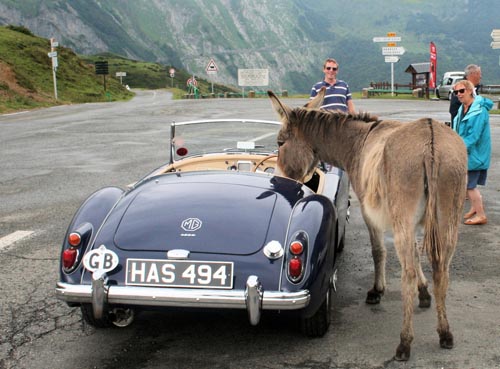
Drivers with an acrophobic fear of heights should not drive the Cirque du Litor. It is a precipitous narrow road cut literally into the side of the almost sheer cliffs adjoining the two Cols, with a tunnel or two along the way. With the narrow damp road and oncoming traffic it required real concentration on the drivers’ part, but with only one way to go the navigators were free to take photos and videos, which they all did.
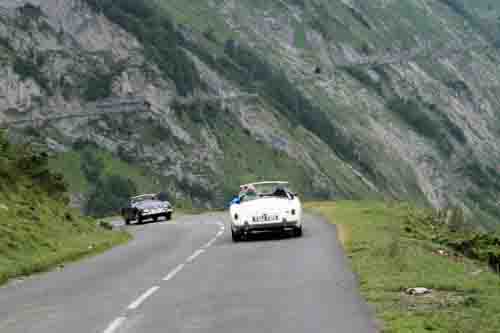
After an enjoyable lunch in the restaurant at the summit of the Col d’Aubisque, and avoiding being run down by an excitable pony, we drove the lovely Vallee d’Ossau, and climbed to almost 6000 ft to cross into Spain via the Col du Portalet. Our hotel for the night, and indeed the whole village of Jaco Barcelo, was quite surreal, being almost deserted like in a post-apocalypse movie. We guessed it was an extreme example of Spanish speculative property development prior to the financial crisis, with just a handful of villas sold. The outdoor pool was quite chilly and only Tom and I braved the water.
Day six commenced with a 4000 ft climb back into France via the 5300ft Col du Somport. No chance of MGAs overheating, though, as it was really chilly and Tom and I had to stop at the top to add an extra layer of clothing. The weather improved as we traversed a string of minor French cols with only wandering cows to impede our progress. It was a lonely day for us as apart from briefly seeing one other crew at our lunch near Larrau we didn’t see a single other MGA. Crossing back into Spain by the 2200 ft Col d’Ispegy we found our progress again slowed by livestock, this time by ponies in the road. By now we were quite used to finding animals in our way, but shortly afterwards were astonished to round a bend and have to brake to avoid several Spanish nuns in full habits walking down the road. That was a first! Navigation was a bit of a challenge here, too, as we were using French maps of this area in Spain where some of the road signs were only in the Basque language.
The following morning all the crews made their way to the finish, where the Pyrenees meet the Atlantic Ocean at Cabo Higuer, just inside the Spanish border. It had rained overnight and was still cloudy and cool, so very different from our Mediterranean start. After the obligatory photos by the crews and visiting tourists, we said our farewells and went our separate ways. Our MGA’s mileage from start to finish was 783 miles, but goodness knows how many feet we had climbed and descended along the way.
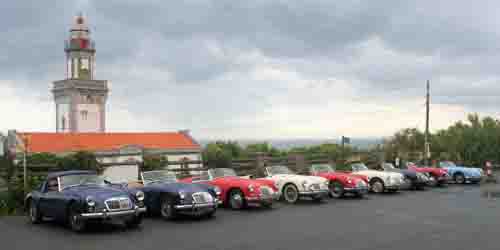
Tom and I then chose a scenic route west following the Spanish coast road via grid-lock in San Sebastian to the surfers’ beach at Deba for lunch. On returning to our parked MGA we were somewhat worried to see a Spanish policewoman waiting for us by the car. However, to our great relief she explained that the man waiting nearby could not speak a word of English but wanted to know all about our car so she would act as translator, and so she did. Neither could believe our MGA was over 50 years old yet had driven the length of the Pyrenees from the Mediterranean coast. Clear blue skies returned after lunch and we completed our coastal route to Elantxobe and then turned inland to Guernica, the town made famous by Picasso’s painting of when the German Air Force bombed it during the Spanish Civil War.
After an overnight stop near Bilbao our MGA might have thought its work was nearly done but, no, Tom had spotted some scenic lakes due south on the road atlas. So off we went on a c.50 mile round trip to view the reservoirs Ullibari and Urrunaga before finally getting on the ferry back to England. We were amused by the contrast of our MGA starting on the button 24 hours later when we reached Portsmouth whilst a new Jaguar nearby needed a jump-start, its motion-sensor alarm having flattened its battery during the voyage.
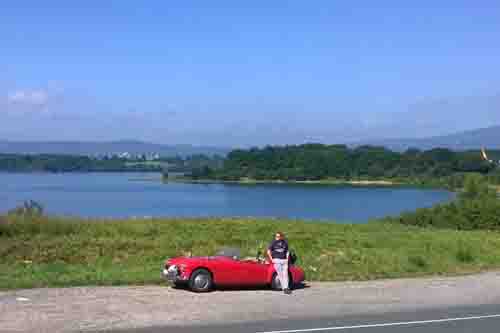
The London orbital motorway was its usual nightmare on the way back to the Thames crossing. Our MGA’s electric fan valiantly kept the engine temperature under control, unlike a classic Jensen 541 that had expired on the approach to the tunnels. So we arrived safely home, having completed a grand total of 1880 miles, a thousand or so less than those who had driven all through France. The nine MGAs must have successfully completed over 20,000 miles between them and, apart from the twin-cam sometimes needing a push-start whilst hot-starting, the only failures were our loose air-horn hose, a failed regulator (a spare was carried), and a broken exhaust strap and wiper blade. Not bad at all.
As Colyn summed up the experience, the Pyrenees are “just a magic place to drive an MGA, so long as you can ignore the temperature gauge!”
Photos by Tom and Roger Martin.

